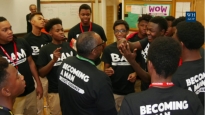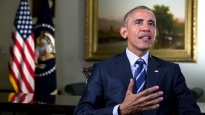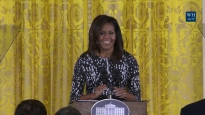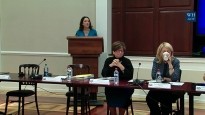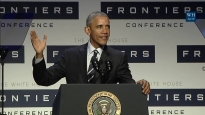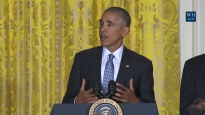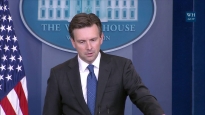President Obama Speaks on Manufacturing Innovation
February 25, 2014 | 20:44 | Public Domain
As a part of this year of action and following up on his 2014 State of the Union, today President Obama announces two new public-private manufacturing innovation institutes – one in Chicago and one in the Detroit area -- as well as a competition for the first of four additional institutes that will put America at the forefront of 21st century manufacturing.
Remarks by the President on Manufacturing Innovation Institutes
East Room
3:19 P.M. EST
THE PRESIDENT: Hello, everybody! Everybody, please have a seat. Thank you. Thank you very much. Hey! Thank you. (Applause.)
Welcome to the White House, everybody. We’ve got some pretty cool stuff up here, and we also have people here who can explain what it all is. But thank you so much for being here. We’ve got, first and foremost, some people who I’m proud to call friends and have been fighting on behalf of American workers every single day.
We’ve got the Governor of the great state of Illinois -- Pat Quinn is here in the house. (Applause.) We’ve got somebody who is responsible for trimming my trees and potholes in front of my house -- (laughter) -- and shoveling snow. And I haven’t been back for a while; I don’t know how it’s going, but I’m assuming he’s handling his business -- the Mayor of the great city of Chicago, Rahm Emmanuel is here. (Applause.) We’ve got Phil LaJoy, who’s the supervisor of Canton Township, Michigan, who is here. There he is. (Applause.) Good job, Phil.
And we’ve got some outstanding members of Congress who are here, especially someone who just announced that this would be his last term in Congress, but is somebody who so many of us have learned from, have admired. He is a man who has every single day of his life, in office, made sure that he was fighting on behalf of people who really needed help. And he’s going to be very missed. John, you are not just the longest-serving member of Congress in American history, you’re also one of the very best. Michigan’s own John Dingell is here. (Applause.) And we are better off because of John’s service, and we’re going to miss you.
Now, today I am joined by researchers who invent some of the most advanced metals on the planet, designers who are modeling prototypes in the digital cloud, folks from the Pentagon who help to support their work. Basically, I’m here to announce that we’re building Iron Man. (Laughter.) I’m going to blast off in a second. (Laughter.) We’ve been -- this has been a secret project we’ve been working on for a long time. (Laughter.) Not really. Maybe. It’s classified. (Laughter.)
But keeping America at the cutting edge of technology and innovation is what is going to ensure a steady stream of good jobs into the 21st century. And that’s why we’re here today -- to take new action to put America at the forefront of 21st century manufacturing.
This is a moment when our economy is growing, and it has been growing steadily for over four years now. Our businesses have created about 8.5 million new jobs over the past four years. The unemployment rate is the lowest it’s been in over five years. Our manufacturing sector is adding jobs for the first time since the 1990s. So there’s some good news to report, but the trends that have battered the middle class for decades have become, in some ways, even starker. While those at the top are doing better than ever, average wages have barely budged. Too many Americans are working harder than ever just to keep up. And it’s our job to reverse those trends.
We’ve got to build an economy that works for everyone, not just a fortunate few. We’ve got to restore opportunity for all people. That’s the essence of America: No matter who you are or where you come from, what you look like, how you started out -- if you are willing to work hard and take responsibility, you can get ahead in America.
So I’ve been talking now for months about an opportunity agenda. And let me break it down into four parts. Number one, more good jobs that pay good wages -- jobs in American manufacturing, rebuilding our infrastructure, innovation, energy. Number two, training workers with the skills they need to fill those jobs. Number three, guaranteed access to a world-class education for every child in America. And number four, making sure that hard work pays off with wages you can live on and savings you can retire on and health insurance you can count on when you need it.
Now, I’m looking forward to working with Congress wherever they’re willing to do something on any of these priorities. And I have to say that the members of Congress who are here all care deeply about these issues. But let’s face it -- sometimes it’s hard to get moving in Congress. We’ve got a divided Congress at this point. And so, in this year of action, wherever I can act on my own to expand opportunity for more Americans, I’m going to seize that opportunity.
And that’s why we’re here today. Already, my administration has launched two hubs for high-tech manufacturing. One is in Youngstown, Ohio and is focused on 3-D printing, an entirely new way by which the manufacturing process can accelerate and supply chains get stitched together, and you integrate design and all the way through production in ways that can potentially be revolutionary. We’ve also focused on energy-efficient electronics in Raleigh, North Carolina. And what happens at each of these hubs is we’re connecting leading businesses to research universities, so they’re able to ensure that America leads the world in the advanced technologies that are going to make sure that we’re at the forefront when it comes to manufacturing.
Now, my friend Congressman Tim Ryan, who’s here today, helped -- where’s Tim? I just saw him, there he is -- helped us get the first of these hubs off the ground. There’s growing bipartisan momentum now behind these efforts. We’ve got two Republicans and two Democrats, Roy Blunt and Sherrod Brown in the Senate, and Tom Reed and Joe Kennedy in the House, that have written bills that would help us create a true network of these hubs all across the country.
So I’m really encouraging Congress to pass these bills. They’re good ideas. And what they do is not only help link up our top researchers with our best business people, but suddenly they become a focal point of opportunity, and businesses around the country and around the world start seeing, huh, if I’m interested in digital technologies that’s the place I should locate. If I’m interested in 3-D printing, let me go there. And so you get a virtuous cycle that can take place. And Congress I think has an opportunity to really expand these in a significant way.
In the meantime, while Congress decides on what it’s going to do, we’re going to go ahead and take some action to launch more of these hubs this year. And today, we’re announcing the next two advanced manufacturing hubs. One is in the Detroit area, and the other is in Chicago, Illinois. (Applause.)
Now, let me describe a little more why this is so important. For generations of Americans, manufacturing was the ticket to a good middle-class life. We made stuff. And the stuff we made -- like steel and cars and planes -- made us the economic leader of the world. And the work was hard, but the jobs were good. And if you got on an assembly plant in Detroit or in a steel plant in Youngstown, you could buy a home. You could raise kids. You could send them to college. You could retire with some security. And those jobs didn’t just tell us how much we were worth, they told us how we were contributing to the society and how we were helping to build America, and gave people a sense of dignity and purpose. They saw a Boeing plane or one of the Big Three cars rolling off the assembly line, and they said, you know what, I made that. And they were iconic. And people understood that’s what it meant for something to be made in America.
Now, advances in technology have allowed manufacturers to do more with less. Global competition means a lot of good manufacturing jobs went overseas. There was just more competition. Folks caught up to us, and they in some cases just copied what we were doing with lower wages, so the competition was fierce. And in the 2000s alone, we lost about one-third of all American manufacturing jobs -- and the middle class suffered for it.
Now, the good news is, today, our manufacturers have added more than 620,000 new manufacturing jobs over the last four years. That’s the first sustained manufacturing growth in over 20 years. But the economy has changed. So if we want to attract more good manufacturing jobs to America, we’ve got to make sure we’re on the cutting edge of new manufacturing techniques and technologies.
And I just have to emphasize here that -- because you’ll hear some people say, well, why are manufacturing jobs so special, and this is a service economy. Nobody believes that we’re going to duplicate all the manufacturing jobs that existed back in the ‘40s and the ‘50s just because the economy has changed. You go into an auto plant now, it’s different then it was. Fewer people can make more cars.
But keep in mind that when we have manufacturing in this country, what ends up happening is that, first of all, there are a whole lot of suppliers to those manufacturers, so that one plant may be deceptive. It doesn't tell you all the companies all across the country that are working on behalf of those manufacturers. The services that are provided to those manufacturers, the advertising that's connected to it, and the architects and the designers and the software engineers -- all those things may not be counted as manufacturing, but by us having those hubs of manufacturing, it has a ripple effect throughout the economy.
So we’ve got to focus on advanced manufacturing to keep that manufacturing here in the United States. That's what’s going to help get the next Stark Industries off the ground. (Laughter.)
So today -- by the way, my Commerce Secretary, Penny Pritzker, is not here because she’s in Silicon Valley meeting with business leaders and talking about how together we can work together to spur economic growth.
The point is, I don't want the next big job-creating discovery to come from Germany or China or Japan. I want it to be made here in America.
And this is one last point I’m going to make about this. Typically, a lot of research and development wants to be co-located with where manufacturing is taking place -- because if you design something, you want to see how is it working and how is it getting made, and then tinker with it and fix it, and try something different. So if all the manufacturing is somewhere else, the lead we’ve got in terms of design and research and development, we’ll lose that too. That will start locating overseas. And we will have lost what is the single most important thing about American economy, and that is innovation.
So that's what all these hubs are about. They’re partnerships that bring together companies and universities to develop cutting-edge technology, train workers to use that technology, and then make sure that the research is translated into real-world products made by American workers.
So the first hub, in Michigan, is going to focus on developing advanced lightweight materials. Detroit has already helping lead the American comeback in manufacturing. Since we stepped in to help our automakers retool, the American auto industry has created almost 425,000 new jobs. And they’ve already begun using new high-strength steel to make lighter cars that use less gas, save money, help save the planet, cars are still safe -- because of these new metals.
And that's just one example of the incredible things these new metals can do. You’re seeing the same thing when it comes to lighter armored vehicles for our troops; planes and helicopters that can carry bigger payloads. If you look at some of the new planes that Boeing is manufacturing, they look lighter; even though they have the same capacity, they use less fuel. Wind turbines that generate more power at less cost. Prosthetic limbs that help people walk again who never thought they could. So we believe there’s going to be an incredible demand for these metals, both from the military and from the private sector, and we want to make sure they're made right here in America. We want our workers to have those jobs. So that's what our first hub is going to do -- focus on making these cool metals.
Second hub -- based in Chicago, but keep in mind this is a consortium of more than 40 companies, 23 universities, labs like Northwestern and the University of Illinois, and nearly 200 small businesses. A number of other states are participating in this consortium. It’s funded by a $70-million award led by the Defense Department, but the state and its businesses raised $250 million in private funding commitments to help win this bid and make it happen.
So this Digital Manufacturing and Design Innovation [Institute] is going to be headquartered not far from downtown Chicago, on Goose Island, where there’s also a very superior beer in case you are -- (laughter and applause) -- I’m just letting you know. (Laughter.) A little hometown plug there. Feel free to use that, Goose Island. (Laughter.) And it’s going to focus on using digital technology and data management to help manufacturers turn their ideas into real-world products faster and cheaper than before. And it will include training to help more Americans earn the skills to do these digital manufacturing jobs.
And this is critical: The country that gets new products to market faster and at less cost, they’ll win the race for the good jobs of tomorrow. And if you look at what’s happening in manufacturing, a lot of it is much more specific. Companies want to keep their inventories low. They want to respond to consumer demand faster. And what that means is, is that manufacturers who can adapt, retool, get something out, change for a particular spec of a particular customer, they’re going to win the competition every time.
And we want that country that is specialized in this to be us, the United States of America. We want suppliers to be able to collaborate with customers in real-time, test their parts digitally, cut down on the time and money that they spend producing expensive prototypes. We want our manufacturers to be able to custom-design products tailored to each individual consumer. We want our troops to be able to download digital blueprints they can use to 3-D print new parts and repair equipment right there in the field. And these are all ambitious goals, but this is America -- that’s what we do, we’re ambitious. We don’t make small planes.
Now, that doesn’t mean we’re going to be able to make all these happen overnight. This stuff takes time. And we also know these manufacturing hubs have the potential to fundamentally change the way we build things in America. So 10 years from now, 20 years from now, imagine our workers manufacturing materials that used to be science fiction -- a sheet of metal that’s thinner than paper but is strong as steel. Or our workers being able to design a product using these materials entirely on a computer, they bring it to market, less money, hire folks to build it right here, sell it all over the world. That’s what the next generation of American manufacturing could look like.
But to get there, we can’t stop at just four of these hubs. I’m really excited about these four hubs; the only problem is Germany has 60 of them. Germany has 60 of them. Part of the reason Germany has been able to take the lead in certain manufacturing areas is because they’ve invested in these hubs and then they invest in the training of the workers for these very precise machines and tools, and that means that that cuts into our market share when it comes to manufacturing around the world.
So we can’t let Germany have 60 and us have four. We’ve got to do better. So I’m hoping that we can get these outstanding members of Congress to push this through so I can sign a bill. But without waiting for Congress, we can launch four new manufacturing hubs this year. That’s our intention. My Department of Energy is announcing the competition for the first of these new hubs today. So to businesses and universities or civic leaders who are watching, start forming those partnerships now. Turn your community into a global center for creating high-tech jobs.
We can’t turn the clock back to earlier, easier times when thousands of Americans would just punch in at a single factory and pound out the products for the industrial age. But thanks in part to our investment and most importantly to the collaboration of some of these outstanding institutions and leaders, factories that once went dark are turning their lights on again. More assembly lines are churning out the cars that the world wants to buy, humming with components of the clean energy age. If we stay focused on winning this race, we will make sure the next revolution in manufacturing is an American revolution. (Applause.) And we’ll make sure that opportunity for all is something that’s made in the USA.
Thanks very much, everybody. Congratulations. Good job. Keep it up. (Applause.)
END
3:40 P.M. EST
|
October 17, 2016
|
October 15, 2016
|
October 14, 2016
|
October 14, 2016
|
|
October 13, 2016
|
October 12, 2016
|
October 12, 2016
|
October 11, 2016
|
- &lsaquo previous
- …
- 14
- 15
- 16
- 17
- 18
- 19
- 20
- 21
- 22
- …
- next &rsaquo
